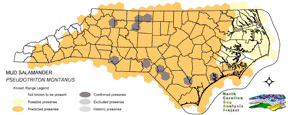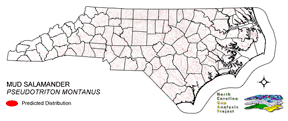
| Taxa: |
| Order: |
| Family: |
| Amphibia |
| Caudata |
| Plethodontidae |
| NatureServe Global Rank: |
| NatureServe State (NC) Rank: |
| G5 |
| S5 |
| Federal Status: |
| NC State Status: |
| --- |
| --- |


| Land Unit |
| US Fish & Wildlife Service |
| US Forest Service |
| US National Park Service |
| US Department of Defense |
| NC State Parks |
| NC University System |
| NC Wildlife Res. Com. |
| NC Forest Service |
| NC Div. of Coastal Mgmt. |
| Local Governments |
| Non-Governmental Org. |
| Other Public Lands |
| Private Lands |
| GAP Status 1-2 |
| All Protected Lands |
| Statewide |
| Hectares |
| 11,322.90 |
| 7,419.96 |
| 11,129.67 |
| 637.29 |
| 3,356.55 |
| 701.82 |
| 7,806.69 |
| 604.11 |
| 609.21 |
| 887.40 |
| 1,771.65 |
| 196.65 |
| 528,937.11 |
| 23,149.74 |
| 44,731.11 |
| 575,381.01 |
| Acres |
| 27,979.49 |
| 18,335.12 |
| 27,502.01 |
| 1,574.78 |
| 8,294.21 |
| 1,734.23 |
| 19,290.75 |
| 1,655.28 |
| 1,505.39 |
| 2,192.81 |
| 4,377.84 |
| 485.93 |
| 1,307,031.81 |
| 57,366.74 |
| 110,695.45 |
| 1,421,959.66 |
| % of Dist. on |
| Prot. Lands |
| 25.3 % |
| 16.6 % |
| 21.5 % |
| 1.4 % |
| 7.5 % |
| 1.6 % |
| 17.1 % |
| 1.4 % |
| 1.4 % |
| 3.9 % |
| 3.9 % |
| 0.3 % |
| < 0.1 % |
| 51.8 % |
| ----- |
| ----- |
| % of Dist. on |
| All Lands |
| 2.0 % |
| 1.3 % |
| 1.9 % |
| 0.1 % |
| 0.6 % |
| 0.1 % |
| 1.4 % |
| 0.1 % |
| 0.1 % |
| 0.2 % |
| 0.3 % |
| < 0.1 % |
| 91.9 % |
| 4.0 % |
| ----- |
| ----- |
|
They are restricted to muddy areas in or near springs, sluggish brooks, and swampy areas (Martof 1975), also muddy streams, sluggish flood-plain pools, and mucky and swampy forested areas along streams (Conant 1975). They often live in and about muddy springs and frequently occur in low wet grounds bordering streams (Bishop 1943). The adults live in leaf accumulations in spring-fed brooks, beneath nearby logs and stones, in damp rock crevices, and in burrows in fine, black organic muck along the banks of seepages, springs, brooks, or swamps (Martof et al. 1980, Petranka 1998). They have been found in vertical burrows in damp, soft mud from 1 m to up to 15-20 m from water (Petranka 1998), and may inhabit water-filled chambers of crayfish burrows (Conant 1975). The eggs are attached to objects in water or are laid in water-filled channels within the banks of streams and ponds (Green and Pauley 1987). Occasionally, they can be found under logs, boards, stones, and leaves in more terrestial habitats (Martof et al. 1980). NATURE SERVE GLOBAL HABITAT COMMENTS: Muddy springs, slow floodplain streams, and swamps along slow streams; backwater ponds and marshes created by beaver activity. Nonlarval forms usually occur beneath logs and rocks, in decaying vegetation, and in muddy stream-bank burrows. Occasionally disperses from wet muddy areas. Secretive, sometimes difficult to detect. Eggs are attached separately to objects in water (e.g., undersides of leaves in quiet pool, (Green and Pauley 1987). |
| Code | Name | Description | NC Natural Heritage Program Equivalent |
| 126 | Interdune Wooded Depression Swamp | Includes swamps dominated by sweetbay and swampbay or dogwood dominated forests. | Maritime Shrub Swamp, Maritime Swamp Forest |
| 380 | Coastal Plain Fresh Water Emergent | Emergent vegetation in fresh water seepage bogs, ponds and riverbeds of the coastal plain. Includes alliances dominated by sedges, eelgrass, as well as cane found in unforested cane-brakes. | Small Depression Pond, Sandhill Seep, Floodplain Pool, Unforested Floodplain Canebrake, Riverscour Prairies, Vernal Pools |
| 173 | Coastal Plain Riverbank Shrubs | Shrub dominated riverbanks, commonly dominated by willows and/or alders. | Sand and Mud Bar |
| 50 | Coastal Plain Mixed Bottomland Forests | Includes forests dominated by a variety of hardwood species, including sweetgum, cottonwood, red maple. | Coastal Plain Bottomland Hardwood (in part), Coastal Plain Levee Forest |
| 49 | Coastal Plain Oak Bottomland Forest | Bottomland forests dominated by deciduous oak alliances. Oaks represented can include swamp chestnut, cherrybark, willow, and/or overcup oak. Inclusions of loblolly pine temporarily flooded forests occur in patches. Hydrology is temporarily to seasonally flooded. | Coastal Plain Bottomland Hardwoods (in part) blackwater subtype, brownwater subtype |
| 158 | Coastal Plain Nonriverine Wet Flat Forests | Loblolly pine - Atlantic white-cedar - red maple - swamp tupelo saturated forests as well as forests dominated by loblolly, sweetgum, and red maple in non-riverine flats. | Non-riverine Wet Hardwood Forest |
| 41 | Peatland Atlantic White-Cedar Forest | Dense stands of Atlantic white cedar with saturated hydrology. Can include swamp tupelo, red maple, and pond pines with a moderate shrub and herb layer. | Peatland Atlantic White-Cedar Forest |
| 15 | Seepage and Streamhead Swamps | Includes extensive peat flats in the coastal plain, dominated by swamp tupelo, maples, and Atlantic white cedar alliances. In the sandhills includes streamhead pond pine and bay forests alliances. Saturated hydrology. | Bay Forest, Small Depression Pocosin, Streamhead Atlantic White Cedar Forest, Streamhead Pocosins |
| 30 | Cypress-Gum Floodplain Forests | Swamps dominated by black or swamp tupelo with or without Taxodium. Seasonally to semi-permanently flooded hydrology. | Cypress-Gum Swamps |
| 78 | Pond-Cypress - Gum Swamps, Savannas and Lakeshores | Cypress dominated swamps and lakeshores. Can include bays dominated by pond cypress or shorelines of coastal plain lakes with a narrow band of cypress. | Non-riverine Swamp Forest, Natural Lakeshores (in part) |
| 385 | Oak Bottomland Forest and Swamp Forest | The swamp chestnut oak, cherrybark oak, shumard oak and sweetgum alliance is one representative. Other alliances are dominated by water, willow, and overcup oaks. Swamp forests can be dominated by sweetgum, red maple, and black gum being dominant. Loblolly can occur in combination with sweetgum and red maple, or with tulip poplar. Includes saturated and semi- to permanently flooded forests in the mountains. | Piedmont/Mountain Bottomland Forest, Piedmont/Mountain Swamp Forest |
| 63 | Coastal Plain Mesic Hardwood Forests | Beech dominated forests with white oak and northern red oak as possible co-dominants. Dry-mesic to mesic forests on slopes and small stream bottoms in the coastal plain. | Mesic Mixed Hardwood Forest, Basic Mesic Forests |
| 87 | Pocosin Woodlands and Shrublands | Includes pond pine woodland, low pocosin and high pocosin shrub dominated areas. Canebrakes and bay forests may be present. | Pond Pine Woodlands, Peatland Canebrake, Small Depression Pocosin |
| 67 | Wet Longleaf or Slash Pine Savanna | Wet flatwoods and pine savannas, typically dominated by longleaf pines, but slash or pond pines may be the dominant pines. | Wet Pine Flatwoods |
| 239 | Piedmont/Mountain Emergent Vegetation | Emergent vegetation of all wetland hydrologies. Sites would commonly support species such as tussock sedge, rushs, and cattail alliances. | Rocky Bar and Shore (in part) |
| 267 | Riverbank Shrublands | Riverside shrubs with temporarily flooded hydrologies. Found in the both the Mountains and Piedmont. Containing dominants such as smooth alder and a Carolina or black willows. | Sand and Mud Bar |
| 269 | Floodplain Wet Shrublands | Saturated shrublands of the Piedmont, includes buttonbush, swamp-loosestrife, decodon and alders. | Piedmont/mountain Semipermanent Impoundment |
| 230 | Piedmont Mesic Forest | American Beech - Red Oak - White Oak Forests. | Mesic Mixed Hardwood |
| 384 | Piedmont/Mountain Mixed Bottomland Hardwood Forests | Includes temporarily to seasonally forests dominated by hardwood species. Hardwoods include sweetgum, red maple, sycamore which co-occur in a mosaic of bottomland and levee positions. Includes alluvial hardwood forests in the mountains. Hemlock and white pine may occur as inclusions, but are generally mapped separately. | Piedmont/Mountain Alluvial Forest, Piedmont/Mountain Levee Forest |
| 8 | Open water | Open water without aquatic vegetation. | No equivalent |
| 517 | Hemlock Floodplain Forest | Alluvial forest with hemlock and/or white pine in mountains and western piedmont. Hydrology is generally temporarily to seasonally flooded. | Canada Hemlock Forest |
| 533 | Appalachian Swamp Forest | Evergreen and deciduous forests with saturated hydrologies. This class may contain a variety of trees species, including hemlock - red maple, pitch pine, and white pine forests. | Swamp Forest-Bog Complex, Southern Appalachian Bog, Southern Appalachian Fen |
| 534 | Appalachian Wet Shrubland/ Herbaceous | Saturated shrubs and herbaceous vegetation. Often mapped as an inclusion in Appalachian Swamp Forest. | Southern Appalachian Bog, Southern Appalachian Fen |
|
Bruce, R. C. 1974. Larval development of the salamander PSEUDOTRITON MONTANUS DIASTICTUS and P. RUBER. Am. Midl. Nat. 92:173-190.
Conant, R. and J. T. Collins. 1991. A field guide to reptiles and amphibians:eastern and central North America. Third edition. Houghton Mifflin Co., Boston, Massachusetts. 450 pp. Martof, B. S. 1975. Pseudotriton montanus. Cat. Am. Amph.Rep. 166.1-166.2. Bruce, R. C. 1975. Reproductive biology of the mud salamander, PSEUDOTRITON MONTANUS, in western North Carolina. Copeia 1975:129-137. Petranka, J. W. 1998. Salamanders of the United States and Canada. Washington DC: Smithsonian Inst. Press. Huheey, J. E., and A. Stupka. 1967. Amphibians and reptiles of Great Smoky Mountains National Park. Univ. Tennessee Press, Knoxville. ix + 98 pp. Barbour, R. W. 1971. Amphibians and reptiles of Kentucky. Univ. Press of Kentucky, Lexington. x + 334 pp. Conant, R. 1975. A Field Guide to Reptiles and Amphibians of Eastern and Central North America. Second Edition. Houghton Mifflin Company, Boston, Massachusetts. xvii + 429 pp. Mount, R. H. 1975. The Reptiles and Amphibians of Alabama. Auburn University Agricultural Experiment Station, Auburn, Alabama. vii + 347 pp. Smith, H. M. 1978. A guide to field identification Amphibians of North America. Golden Press, New York. Behler, J. L., and F. W. King. 1979. The Audubon Society field guide to North American reptiles and amphibians. Alfred A. Knopf, New York. 719 pp. Martof, B. S., W. M. Palmer, J. R. Bailey, and J. R. Harrison, III. 1980. Amphibians and reptiles of the Carolinas and Virginia. University of North Carolina Press, Chapel Hill, North Carolina. 264 pp. Green, N. B., and T. K. Pauley. 1987. Amphibians and reptiles in West Virginia. University of Pittsburg Press, Pittsburg, Pennsylvania. xi + 241 pp. Ashton, R. E., Jr., and P. S. Ashton. 1988. Handbook of reptiles and amphibians of Florida. Part Three. The amphibians. Windward Publ. Co., Miami. Bruce, R. C. 1969. Fecundity in primitive plethodontid salamanders. Evolution 23:50-54. Collins, J. T. 1991. Viewpoint:a new taxonomic arrangement for some North American amphibians and reptiles. SSAR Herpetol. Review 22:42-43. Dundee, H. A., and D. A. Rossman. 1989. The amphibians and reptiles of Louisiana. Louisiana State Univ. Press, Baton Rouge. Pfingsten, R. A., and F. L. Downs, eds. Salamanders of Ohio. Bull. Ohio Biological Survey 7(2):xx + 315 pp. |
For more information please contact them at:
NC-GAP Analysis Project
Dept. of Zoology, NCSU
Campus Box 7617
Raleigh, NC 27695-7617
(919) 513-2853
www.basic.ncsu.edu/ncgap